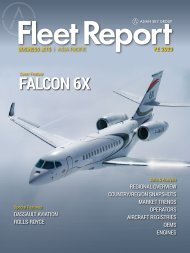Asia-Pacific AAM Report 1H 2023
You also want an ePaper? Increase the reach of your titles
YUMPU automatically turns print PDFs into web optimized ePapers that Google loves.
INTERVIEW WITH STUTTGART UNIVERSITY OF APPLIED SCIENCES<br />
frameworks must also encompass compliance with existing<br />
aviation regulations, even as they factor in the integration of<br />
non-automated aircraft sharing the same airspace. The fact that<br />
Joby Aviation has taken the lead by becoming the first Advanced<br />
Air Mobility (<strong>AAM</strong>) company to receive certification from the<br />
International Standard for Business Aircraft Operators (IS-BAO)<br />
is a testament to its dedication to safety commitments within this<br />
sector.<br />
The resolution of these operational challenges will undoubtedly<br />
have a direct impact on user trust and the rate of adoption of<br />
eVTOLs as a viable mode of transportation.<br />
Psychological Implications: Changing<br />
Perception is Key<br />
In light of the current eVTOL landscape, the shift towards<br />
autonomous eVTOLs undeniably carries significant psychological<br />
implications for both users and operators.<br />
Potential users must overcome<br />
biased perceptions that<br />
inherently mistrust machine<br />
capabilities when compared to<br />
human competence.”<br />
For pilots, an existential crisis looms on the horizon as the cockpit<br />
empties out. Their roles are undergoing inevitable transformation,<br />
transitioning from aviators to instrumental operators overseeing<br />
autonomous systems. Nevertheless, pilots are poised to remain<br />
indispensable in mitigating operational risks and ensuring<br />
passenger safety. They will serve as a vital component in a<br />
complex safety system that will likely involve advanced AI<br />
interventions for assistance.<br />
As the pilot shortage looms large, exerting pressure on existing<br />
commercial aviation operations, automation developments within<br />
the eVTOL domain could potentially address the manpower<br />
shortfall while simultaneously safeguarding pilots from burnout<br />
resulting from overloaded flight schedules.<br />
Trust emerges as the psychological linchpin in driving the<br />
implementation of autonomous eVTOLs. Drawing from the realm<br />
of self-driving cars, the concept of "trust in automation" becomes<br />
equally relevant here. However, it is important to emphasize that<br />
multiple levels of trust are at play in eVTOL operations. These<br />
levels encompass trust and perceptions towards various aspects<br />
of the eVTOL ecosystem, including trust in flight technology, trust<br />
in automation and regulatory systems, and perceived trust in the<br />
operator.<br />
Perceived trust simultaneously includes people indirectly involved<br />
within the ecosystem. The European Union Aviation Safety<br />
Agency (EASA) has conducted feasibility studies across Europe,<br />
shedding light on the significance of considering concerns from<br />
local residents and the broader public regarding their surrounding<br />
environment. Factors such as noise levels in an increasingly<br />
crowded airspace could potentially disrupt their way of life,<br />
necessitating careful attention. According to EASA Executive<br />
Director Patrick Ky, the agency’s first worldwide assessment<br />
(Environmental Protection Technical Specifications) for regulating<br />
noise levels to facilitate type certification of eVTOLs will become<br />
a benchmark to both measure and limit aircraft noise emitted<br />
during different stages of an eVTOL flight.<br />
Building trust among users and operators hinges on perceiving<br />
the autonomous ecosystem as reliable, transparent, and capable<br />
of effectively handling unforeseen circumstances. Therefore,<br />
operators must clearly communicate the capabilities of their<br />
autonomous systems, providing substantial evidence of their<br />
dependability. Business psychologist Prof. Dr. Patrick Planing<br />
suggests that eVTOL companies should take a crucial step by<br />
conducting additional pilot studies and test rounds, offering the<br />
general public more exposure to the technology and opportunities<br />
to witness or experience autonomous systems in close proximity.<br />
Potential users could be afforded the chance to familiarize<br />
themselves with autonomous eVTOLs in controlled and simulated<br />
environments, potentially supported by virtual reality. This<br />
approach would undoubtedly alleviate embedded concerns<br />
and fears surrounding the flight experience. Through deeper<br />
interaction with automation in action, perceptions of flying<br />
autonomously can gradually change on a larger scale than<br />
currently available.<br />
As of the time of writing, the Federal Aviation Administration<br />
(FAA) has recently unveiled a blueprint outlining plans to initiate<br />
small-scale air taxi operations utilizing existing infrastructure<br />
and implementing gradual procedural changes in flight corridors<br />
to accommodate the growing eVTOL traffic flowing in multiple<br />
directions. Created collaboratively with industry stakeholders<br />
and NASA, this blueprint aims to serve as a guideline to support<br />
further research endeavors and steps towards implementation.<br />
It also seeks to instill confidence among the general public by<br />
54 | <strong>1H</strong> <strong>2023</strong> ASIA-PACIFIC <strong>AAM</strong> REPORT
















